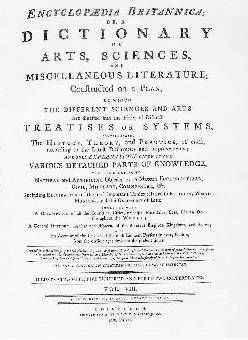
 |
|
 |
autore History
|
|||||||
|
|||||||||
|
Editorial NoteThis Html version has been conducted on the entry: "History", Encyclopaedia Britannica; or, a Dictionary of Arts, Sciences, and Miscellaneous Literature; Constructed on a Plan, by which the different Sciences and Arts are digested into the Form of Distinct Treatises or Systems, comprehending the History, Theory, and Practice, of each, according to the Latest Discoveries and Improvements […]. The Third Edition, in Eighteenth Volumes, Greatly Improved, ed. by C. Macfarquhar (vols. 1-12) and G. Gleig (vols. 13-18), Edinburgh, 1797, vol. VIII, pp. 561-600. The article "History", that we publish here, is taken from the eighth volume of the third edition of Encyclopaedia Britannica. The first edition of Britannica, edited by William Smellie, was published in a serial form between 1768 and 1771, and in a complete 3 volume edition in 1771 and 1773. From 1777 to 1784, it had a second edition, first in serial form and then in complete form in 10 volumes, entirely edited by James Tytler. Following the directions of the two publishers, he enlarged the work to include historical, political and biographical issues; in fact the entry "History" appears here for the first time (vol. V, 1780, pp. 3649-88). The third edition of Britannica, edited by the publisher Macfarquhar himself and, after his death, by Dr. George Gleig, reached 18 volumes and began to involve a number of experts and professors of Edinburgh University; it involved fields of research, which were not considered yet in the contemporaneous dictionaries and encyclopaedias, and became the model for all the following editions up till the XXth century. The article "History" in the third edition was not altered significantly from that in the second edition. The only true change was the addition of the final paragraph of "Civil history" accounting for the American and French Revolution in a surprising liberal way. Nevertheless, the article is inserted in a strict ideological scheme intended to be an alternative to the French Encyclopédie. It is immediately clear that there is a strong defence of the Biblical chronology and of the Mosaic account, which, in contrast to the entry "Histoire" written by Voltaire, are considered the real basis of the work of the historian. Moreover, the idea of the encyclopaedia itself contrasts sharply with the Encyclopédie: Voltaire affirms that "un article doit corriger l'autre; & s'il se trouve ici quelque erreur, elle doit être relevée par un homme plus éclairé" ("Histoire", Encyclopédie, VIII, 1765, p. 224); on the contrary, the editors of the Britannica assert that all the entries must refer to a whole coherent philosophical system. This emerges from the structure of the encyclopaedic article, which we have tried to preserve here. "History" is divided in an introductory general definition followed by three main sections: "Civil History", "Ecclesiastical History", "Of the Composition of History". The marginalia, which help the reader to follow the argument, organise the references in a hierarchy, as is shown in their numbering. The underlined words cross-reference to other entries in the Britannica, or to parts of them. An "Historical Chart" designed by Adam Ferguson ends the article, illustrating within the limits of Biblical chronology both sacred and profane history. We corrected any misprints or accidental mistakes, but we have maintained all other typographical and orthographic peculiarities of the original text. The original pagination is indicated by numbers in bold type between square brackets. To preserve the original structure of the article, some files are rather large and might take some time to be loaded. Selected BibliographyAbbattista, G., "La 'folie de la raison par alphabet'. Le origini settecentesche dell'Encyclopaedia Britannica 1768-1801", in L'enciclopedismo in Italia nel XVIII secolo, Studi Settecenteschi, 16, 1996, 435-476. Castagneto, P., "Uomo, natura e società nelle edizioni settecentesche dell'Encyclopaedia Britannica", L'enciclopedismo in Italia nel XVIII secolo, Studi Settecenteschi, 16, 1996, 435-476. Einbinder, H.,The Myth of the Britannica, London, 1964. Gooiding, L. M., "The Encyclopaedia Britannica: a critical and historical study", unpublished Master Thesis, Columbian University, 1929. Kafker, F. A., ed., Notable Encyclopaedias of the Late Eighteenth Century: Eleven Successors of the "Encyclopédie", Studies on Voltaire and the eighteenth century, vol. 315, 1994. Kogan, H., The great EB; the story of the Encyclopaedia Britannica, Chicago, 1958. Kruse, P., "The story of the Encyclopaedia Britannica, 1768-1943", Ph.D., University of Chicago, 1958. Lough, J.,"The Encyclopédie in Eightenth-Century England", French Studies, 1952, 289-307. Preece, W. E., "The Organization of knowledge and the Planning of Encyclopaedias:
The Case of the Encyclopaedia Britannica", Cahiers d'histoire mondiale,
9, 1966, 799-819. |
|||||||||
| note | |||||||||